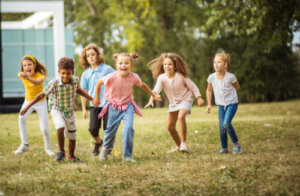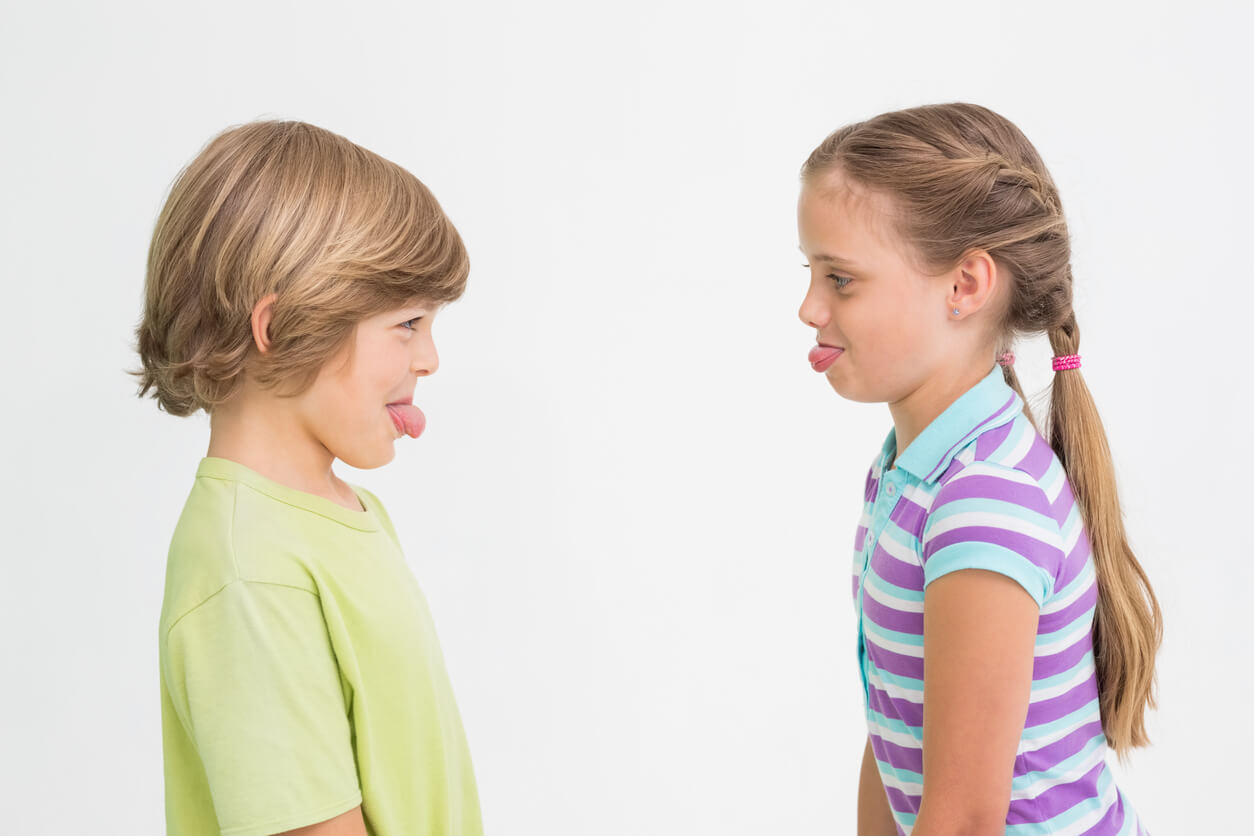5 Games that Promote Self-Control in Children


Written and verified by the psychologist Maria Fátima Seppi Vinuales
Most adults have at some time received a note in their child’s school notebook because their child hit a classmate in a fight or broke a toy because they wouldn’t lend them another one. Undoubtedly, as parents, one of the first reactions is to get angry and scold the child. However, after that, the question of what to do so that such a situation doesn’t happen again remains in the air. Therefore, it’s important to promote self-control through games and activities. In the following article, we’ll share some suggestions.
You may be interested in: How to Teach Problem-Solving Skills to Kids
5 games that promote self-control in children
Some games and activities that contribute to the development of self-control in children are the following:
1. Turn yourself into a balloon
One of the first things we can teach children is how to breathe. When the brain is overwhelmed with emotions, proper breathing brings an influx to help restore peace and calm. So, according to age, we can ask the child to blow up like a balloon as much as possible and then, little by little, begin to let the air out.
If possible, we can guide them to think about how they feel as they breathe, and, as they let the air out, imagine some pleasant emotion or situation.

2. The statue game
This dynamic allows children to explore and move around the space as they please, as long as the music is playing in the background. When the melody stops, the children must remain still in the same position they were in. They’ll only be able to move when the music starts again. Instead of music, we can also simply give an order to stay frozen like statues.
3. Traffic light technique
Although it’s a game, it’s a very popular technique that helps to promote self-control in children. This is because it allows you to lay the foundations for emotional regulation and self-control. It involves drawing a traffic light on a piece of paper and indicating to the child that green represents the correct and desired behavior; yellow sends us an alarm signal that we’re on the borderline between right and wrong; and red implies stopping completely, for our own good and that of other people.
In the beginning, we can be the ones to indicate the colors of the traffic light and, as they grow, it will be the children themselves who will self-evaluate their behavior. The technique can be enriched by brainstorming the best actions to consider when we want to calm down. For example, breathing or counting to 10, among others.
4. The opposite game
The goal of this game is to think about our own emotions and also consider those of others when acting. It’s performed as follows:
- Make two paper hats.
- Two partners must play the game while facing one another.
- One of the children puts on a hat and offers the other hat to their partner.
- Whoever initiates the game must perform an activity and their partner must look at them and perform the opposite action. For example, if the child cries, the other child must laugh; if the child remains silent, the other child must speak.

5. Simon says
This classic game helps us to comply with the rules and to control our movements and desires. There must be a coordinator or guide who gives the instructions, such as: “Simon says to jump, to cry, to shout, to dance, to be silent, to sing, or to close our eyes”. The children must follow and carry out each of the instructions.
The idea is to intersperse some of the instructions that involve a lot of action with others that require slowing down and calming down. This way, little ones will be tempted to continue with a moving action, but then they’ll have to remain silent and still in place. Thus, little by little, they begin to exercise self-control.
Importance of self-control in children
Self-control is essential at any time in our lives. It speaks of our ability to self-regulate, set our own limits, and be respectful and assertive with those around us. In turn, this skill also has to do with good relationships, the quality of our bonds, and social integration.
Finally, according to different research, self-control is also linked to better academic performance.
You may be interested in: Self-Regulation in Learning According to Richard Fenker
To promote self-control, be the example you want your child to follow
Finally, it’s important to remember that, in the eyes of children, adults are their significant reference figures. So, if when driving the car you get angry and yell at another driver who committed an infraction, minors will understand that this is the correct or appropriate way to react.
So, practicing self-control starts at home. Sometimes, after a long day, comes “the straw that broke the camel’s back”. However, we also need to know how to find strategies to breathe, calm down, and set limits. It’s not an easy task, but it’s a necessary skill for living in community.
Most adults have at some time received a note in their child’s school notebook because their child hit a classmate in a fight or broke a toy because they wouldn’t lend them another one. Undoubtedly, as parents, one of the first reactions is to get angry and scold the child. However, after that, the question of what to do so that such a situation doesn’t happen again remains in the air. Therefore, it’s important to promote self-control through games and activities. In the following article, we’ll share some suggestions.
You may be interested in: How to Teach Problem-Solving Skills to Kids
5 games that promote self-control in children
Some games and activities that contribute to the development of self-control in children are the following:
1. Turn yourself into a balloon
One of the first things we can teach children is how to breathe. When the brain is overwhelmed with emotions, proper breathing brings an influx to help restore peace and calm. So, according to age, we can ask the child to blow up like a balloon as much as possible and then, little by little, begin to let the air out.
If possible, we can guide them to think about how they feel as they breathe, and, as they let the air out, imagine some pleasant emotion or situation.

2. The statue game
This dynamic allows children to explore and move around the space as they please, as long as the music is playing in the background. When the melody stops, the children must remain still in the same position they were in. They’ll only be able to move when the music starts again. Instead of music, we can also simply give an order to stay frozen like statues.
3. Traffic light technique
Although it’s a game, it’s a very popular technique that helps to promote self-control in children. This is because it allows you to lay the foundations for emotional regulation and self-control. It involves drawing a traffic light on a piece of paper and indicating to the child that green represents the correct and desired behavior; yellow sends us an alarm signal that we’re on the borderline between right and wrong; and red implies stopping completely, for our own good and that of other people.
In the beginning, we can be the ones to indicate the colors of the traffic light and, as they grow, it will be the children themselves who will self-evaluate their behavior. The technique can be enriched by brainstorming the best actions to consider when we want to calm down. For example, breathing or counting to 10, among others.
4. The opposite game
The goal of this game is to think about our own emotions and also consider those of others when acting. It’s performed as follows:
- Make two paper hats.
- Two partners must play the game while facing one another.
- One of the children puts on a hat and offers the other hat to their partner.
- Whoever initiates the game must perform an activity and their partner must look at them and perform the opposite action. For example, if the child cries, the other child must laugh; if the child remains silent, the other child must speak.

5. Simon says
This classic game helps us to comply with the rules and to control our movements and desires. There must be a coordinator or guide who gives the instructions, such as: “Simon says to jump, to cry, to shout, to dance, to be silent, to sing, or to close our eyes”. The children must follow and carry out each of the instructions.
The idea is to intersperse some of the instructions that involve a lot of action with others that require slowing down and calming down. This way, little ones will be tempted to continue with a moving action, but then they’ll have to remain silent and still in place. Thus, little by little, they begin to exercise self-control.
Importance of self-control in children
Self-control is essential at any time in our lives. It speaks of our ability to self-regulate, set our own limits, and be respectful and assertive with those around us. In turn, this skill also has to do with good relationships, the quality of our bonds, and social integration.
Finally, according to different research, self-control is also linked to better academic performance.
You may be interested in: Self-Regulation in Learning According to Richard Fenker
To promote self-control, be the example you want your child to follow
Finally, it’s important to remember that, in the eyes of children, adults are their significant reference figures. So, if when driving the car you get angry and yell at another driver who committed an infraction, minors will understand that this is the correct or appropriate way to react.
So, practicing self-control starts at home. Sometimes, after a long day, comes “the straw that broke the camel’s back”. However, we also need to know how to find strategies to breathe, calm down, and set limits. It’s not an easy task, but it’s a necessary skill for living in community.
All cited sources were thoroughly reviewed by our team to ensure their quality, reliability, currency, and validity. The bibliography of this article was considered reliable and of academic or scientific accuracy.
- Andrés, M. L., Castañeiras, C. E., & Richaud, M. C. (2014). Relaciones entre la personalidad y el bienestar emocional en niños. El rol de la regulación emocional. Cuadernos de Neuropsicología/Panamerican Journal of Neuropsychology, 8(2), 217-241.
- Bilbao, Alvaro (2015) El cerebro del niño explicado a los padres.Plataforma Actual.
This text is provided for informational purposes only and does not replace consultation with a professional. If in doubt, consult your specialist.








